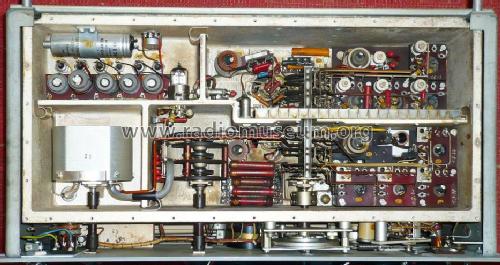Leistungs-Messsender SMLR (BN41001)
Rohde & Schwarz, PTE; München
- Pays
- Allemagne
- Fabricant / Marque
- Rohde & Schwarz, PTE; München
- Année
- 1957–1978 ??
- Catégorie
- Appareils de mesure et de dépannage (matériel de labo)
- Radiomuseum.org ID
- 99793
-
- alternative name: Messgerätebau Memmingen || Physikalisch-Technisches Entwicklungslabor Dr. Rohde & Dr. Schwarz
Cliquez sur la vignette du schéma pour le demander en tant que document gratuit.
- No. de tubes
- 4
- Gammes d'ondes
- Bandes en notes
- Tension / type courant
- Alimentation Courant Alternatif (CA) / 115-235 Volt
- Haut-parleur
- - - Pas de sortie basse fréquence
- Matière
- Boitier métallique
- De Radiomuseum.org
- Modèle: Leistungs-Messsender SMLR - Rohde & Schwarz, PTE; München
- Forme
- Modèle de table profil bas (grand modèle).
- Dimensions (LHP)
- 540 x 301 x 378 mm / 21.3 x 11.9 x 14.9 inch
- Remarques
- Leistungs-Messsender 0,1...30 MHz in 5 Teilbereichen. Ausgangspegel -60...-40/-30/-20/-10/0/+10 db an 60 Ohm. Eigenmodulation 1000 Hz, 30 %. Fremdmodulation 30 Hz...10 kHz, 0...70 %.
- Poids net
- 27 kg / 59 lb 7.5 oz (59.471 lb)
- Prix de mise sur le marché
- 4,680.00 DM
- Littérature
- -- Collector info (Sammler)
- Schémathèque (1)
- -- Original-techn. papers.
- Auteur
- Modèle crée par Jos Lauth. Voir les propositions de modification pour les contributeurs supplémentaires.
- D'autres Modèles
-
Vous pourrez trouver sous ce lien 552 modèles d'appareils, 510 avec des images et 253 avec des schémas.
Tous les appareils de Rohde & Schwarz, PTE; München
Collections
Le modèle Leistungs-Messsender fait partie des collections des membres suivants.
Contributions du forum pour ce modèle: Rohde & Schwarz, PTE: Leistungs-Messsender SMLR
Discussions: 1 | Publications: 9
Guten Tag an die Gemeinschaft
ich habe vor kurzem so ein Gerät erworben; es ist nach ersten Versuchen auf allen Bereichen funktionstüchtig und noch gut justiert..
Kann mir jemand sagen, warum hier als HF Ausgangsimpedanz 60 Ohm gewählt wurden, wo doch die gängingen AM Antennen und Empfänger überwiegend 50 oder 75 Ohm haben oder gehabt haben?
Gerhard Schoenbauer, 19.Oct.20















































